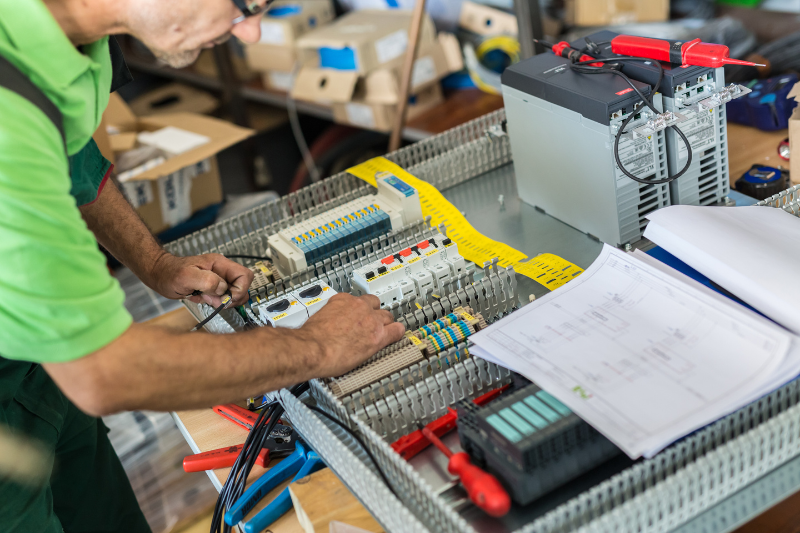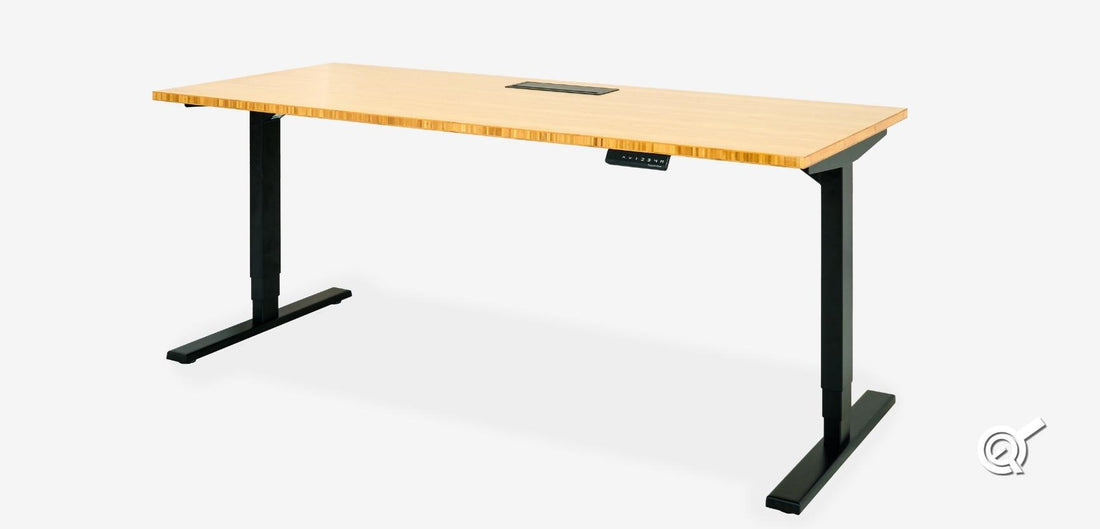Standing desks continue growing in popularity as home and office solutions by promoting healthier work habits through a more active work style. In most cases, the height adjustable systems for standing desks can be driven or assisted into position through electricity, pressurized fluid, or compressed air. In this post, we will be comparing the characteristics found in most hydraulic, pneumatic, and electric standing desks to help you better understand which type will be the best match for your needs.

What are the Benefits of a Standing Desk?
In general, good quality standing desks offer major health benefits for their users through proper ergonomics and comfort, leading to a long-term positive impact on our mood, productivity, posture, and mental health. The option to stand up can help increase overall work performance and concentration by helping users feel more awake compared to when seated down. With desks and monitors adjusted to the correct height, neck strain and back slumping can be eliminated from our day.
Productivity also improves from having better morale and proper posture when adjusting a workspace to the ideal height position of each user. This is because a comfortable working position reduces the rate of workplace injuries that happen from improper posture. When compared to non-adjustable desks, height adjustable standing desks also offer the added versatility of being able to adjust for the varying heights of different users who may take turns sharing the same workstation.

How do Electric Standing Desks Work?
Electric adjustable standing desks use electric motors to convert electrical power into mechanical force. This mechanical force is then translated to linear motion for moving the motorized legs to the user’s desired position. In our electric standing desk technology, we use brushed DC motors in conjunction with gears to allow for the necessary speed reduction for greater torque and a higher weight capacity.
Control boxes are essentially the brains of our electric stand up desks. They are responsible for reading the positions each leg has traveled to and would then output the necessary amount of power to ensure the legs move to the desired position synchronously. By adjusting how much power is coming from the output, the control box can detect and correct for most disturbances such as uneven weight distribution, aging motors, and physical obstructions. For a control box to determine what positions their electric motors have traveled to, there will be a type of positional feedback involved in the system such as our hall effect sensors.

As the motor of our electric stand up desks rotates, square pulses of 5 Volts are being generated from the hall effect sensors. These pulses will then be counted by our control box to accurately determine the positions that each leg has traveled to. Electronic remote controllers allow users the ability to provide inputs to the control box of their desk, ultimately moving it up and down. By activation of the remote, signals from the remote are sent to the input ports of the control box. The control box determines how much power needs to be supplied to the output ports for the motorized legs to reach the set point(s) which was commanded by the user holding the remote.
How do Pneumatic Standing Desks Work?
Pneumatic standing desks operate in a similar way to our mechanical desk converters that use gas-assisted springs. Compressed gas such as nitrogen flows from one end of the piston to the other through their valve openings.

The completely sealed unit has the same pressure on both sides, however, the pressure acts over a greater surface area from behind the shaft when compared to the front of the shaft’s base. This is because the shaft’s center takes up some surface area from the front side, resulting in a greater amount of force experienced from behind to push the rod out during extensions.

Applying enough weight or force against the shaft will cause the shaft to move further inwards and retract. Compressed gas then goes through the valve opening and will keep getting more compressed until the shaft has fully retracted, or the applied weight is equal to the force exerted by the gas-assisted spring. This compression is happening because the shaft is now occupying space that was previously taken up by the gas. If the weight applied against the shaft becomes less than the force exerted by the gas-assisted spring, the shaft will begin extending once more. Users will usually need to manually adjust the tension settings of their pneumatic sit stand desk using a wrench to account for any changes in weight applied to the top of the workstation.
These gas-assisted springs help reduce the amount of manual effort required by their users to move the workstation to the desired height position. Once the user has chosen their preferred height, a pneumatic sit stand desk will then have a type of lever mechanism for users to lock the gas-assisted springs into place.
How do Hydraulic Standing Desks Work?
Instead of using compressed air, hydraulic standing desks use pressurized fluids inside their hydraulic cylinders to transmit mechanical energy when changing the height positions of a workstation. Since hydraulic fluid does not compress like gases, there is much less power loss within the system. These hydraulic cylinders function similarly to hydraulic floor jacks for lifting cars, capable of high force outputs while in a compact size.

Different models of hydraulic adjustable standing desks will come with either a manual crank or an electric hydraulic pump for propelling the pressurized fluid. The most complex type of hydraulic standing desk will have a combination of hydraulic and electric systems working together to achieve similar smart features found in electric standing desks. Some models may also have the option to switch to a manual crank if a power outage was preventing the normal use of its electric hydraulic pump.
Which Type of Standing Desk is Best?
The best type of standing desk for you will depend on your personal preferences, budget constraints, user requirements, and environmental settings. Hydraulic standing desks excel in areas such as industrial factories and heavy-duty manufacturing setups that require the most stability, largest workstation surface area, and highest weight capacity ratings to handle heavy industrial loads. Portability is not crucial for these types of setups since they will rarely need to move locations after being installed. Noisy environments like manufacturing facilities also do not require standing desks with quiet operation, making the noise of electric-controlled hydraulic desks perfectly fine.

Hydraulic vs. Electric Standing Desks
|
Hydraulic Standing Desks |
Electric Standing Desks |
|
- Higher weight capacity - Allows for larger working surface area - Greater stability |
- Requires fewer components to operate - Greater portability - Affordable price point - Less noise than electric-controlled hydraulic desks - Lower environmental impact |
Pneumatic standing desks are an excellent choice for users that require a portable workstation, prefer quiet operation, and prioritize a fast height adjustment speed. Since pneumatic standing desks do not require electricity, users can take these desks anywhere for as long as they need without having to recharge portable batteries. Pneumatic sit stand desks are also suitable for users who were willing to apply some manual force to change height positions, do not mind a lower weight capacity, and prefer smaller-sized workstations.

Pneumatic vs. Hydraulic Standing Desks
|
Pneumatic Standing Desks |
Hydraulic Standing Desks |
|
- Faster height adjustment speed - Greater portability - Requires fewer components to operate - Less noise than electric-controlled hydraulic desks - Affordable price point - Lower environmental impact |
- Higher weight capacity - Allows for larger working surface area - Greater stability - Electric-controlled hydraulic desks require no physical effort to change height positions - No tension setting changes are required when workspace changes weight |
Most home and office settings will find electric standing desks as solid all-rounders for users who enjoy smart features, require moderate weight capacity, and prefer the convenience of electric motors that do all the physical work when changing height positions. Users who are elderly, injured, or physically limited will find the convenience of automatic electric motors especially useful. Certain models of electric standing desks can also work with portable rechargeable batteries for greater portability and operation without access to wall outlets. The advanced technology behind electric stand up desks will also allow for a standing desk configuration with three legs that move synchronously if users require more weight capacity or L-shaped desks with larger surface area.

Pneumatic vs. Electric Standing Desks
|
Pneumatic Standing Desks |
Electric Standing Desks |
|
- Faster height adjustment speed - Greater portability - Requires fewer components to operate - Requires no electricity - Less noise than lower-end electric standing desks |
- Higher weight capacity - Greater stability - Allows for larger working surface area - No tension setting changes are required when workspace changes weight - Requires no physical effort to change height positions - Electronics allow for smart technology safety features and three leg configurations - Greater accuracy and precision to reach the user’s exact comfortable preset positions |
In Summary
Hydraulic, pneumatic, and electric standing desks all come with different benefits and drawbacks to excel in different use cases. By understanding each type and choosing the best drive system for your specific use case, you too can experience the primary benefits of a standing desk and boost work productivity.
We hope you found this as informative and interesting as we did, especially if you were comparing hydraulic, pneumatic, and electric standing desks before getting your next workstation. If you have any queries about our standing desks or have trouble picking out the right accessories to suit your workspace needs, feel free to reach out to us! Our team of representatives is experts in what we do and will be happy to help with any questions you may have!
sales@progressivedesk.com | 1-800-828-9414


